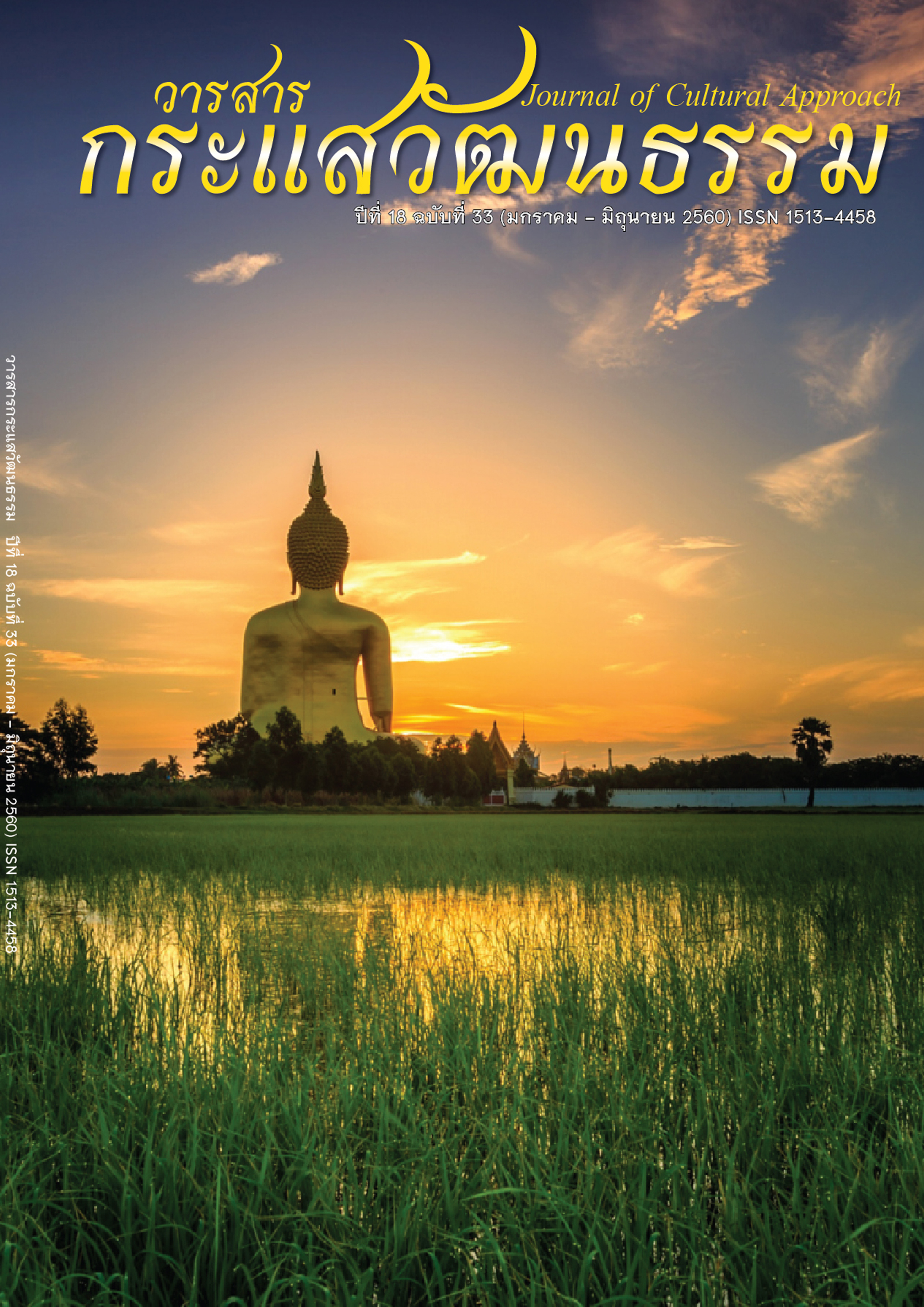การศึกษาศักยภาพอุตสาหกรรมการท่องเที่ยวเชิงสุขภาพของรัฐเกรละ ประเทศอินเดีย
Main Article Content
บทคัดย่อ
การวิจัยครั้งนี้เป็นการวิจัยเชิงคุณภาพโดยมีวัตถุประสงค์เพื่อศึกษาสถานการณ์ รูปแบบ และแนวโน้มการท่องเที่ยวเชิงสุขภาพ และวิเคราะห์ศักยภาพในด้านแหล่งท่องเที่ยวและส่วนประสมทางการตลาดท่องเที่ยวที่รองรับการท่องเที่ยวเชิงสุขภาพในของรัฐเกรละ ประเทศอินเดีย เครื่องมือในการวิจัยครั้งนี้ได้แก่ แบบสังเกตและแบบสัมภาษณ์กึ่งโครงสร้าง (Semi-Structured Interview) และจัดกระทำข้อมูลด้วยวิธีการวิเคราะห์เนื้อหา (Content Analysis) โดยกลุ่มตัวอย่าง คือ เจ้าของกิจการที่เกี่ยวข้องกับการท่องเที่ยวเชิงสุขภาพของรัฐเกรละ ประเทศอินเดีย และมัคคุเทศก์ท้องถิ่น จำนวน 7 คน ที่เลือกอย่างเจาะจง (Purposive Sampling) ในพื้นที่ 4 เมืองหลักของรัฐเกรละ ได้แก่เมือง Trivandrum Alleppey Kumarakom และ Cochin ผลการวิจัยพบว่า การท่องเที่ยวเชิงสุขภาพของรัฐเกรละในประเทศอินเดีย ใช้หลักการของอายุรเวท ซึ่งเหมือนกันทุกแห่ง ด้านแนวโน้มของการท่องเที่ยวเชิงสุขภาพของรัฐเกรละ ประเทศอินเดียนั้นมีแนวโน้มที่ดีขึ้นอย่างต่อเนื่อง อีกทั้งจัดการรูปแบบท่องเที่ยวเชิงสุขภาพได้สอดคล้องแหล่งท่องเที่ยวธรรมชาติ โดยมีการใช้ความเป็นอินเดียโบราณผสมผสานกับการจัดการการท่องเที่ยวตามแบบตะวันตก เพื่อเพิ่มมูลค่าและก่อให้เกิดความพึงพอใจแก่นักท่องเที่ยวสูงสุด
Article Details
Proposed Creative Commons Copyright Notices
1. Proposed Policy for Journals That Offer Open Access
Authors who publish with this journal agree to the following terms:
- Authors retain copyright and grant the journal right of first publication with the work simultaneously licensed under a Creative Commons Attribution License that allows others to share the work with an acknowledgement of the work's authorship and initial publication in this journal.
- Authors are able to enter into separate, additional contractual arrangements for the non-exclusive distribution of the journal's published version of the work (e.g., post it to an institutional repository or publish it in a book), with an acknowledgement of its initial publication in this journal.
- Authors are permitted and encouraged to post their work online (e.g., in institutional repositories or on their website) prior to and during the submission process, as it can lead to productive exchanges, as well as earlier and greater citation of published work (See The Effect of Open Access).
Proposed Policy for Journals That Offer Delayed Open Access
Authors who publish with this journal agree to the following terms:
- Authors retain copyright and grant the journal right of first publication, with the work [SPECIFY PERIOD OF TIME] after publication simultaneously licensed under a Creative Commons Attribution License that allows others to share the work with an acknowledgement of the work's authorship and initial publication in this journal.
- Authors are able to enter into separate, additional contractual arrangements for the non-exclusive distribution of the journal's published version of the work (e.g., post it to an institutional repository or publish it in a book), with an acknowledgement of its initial publication in this journal.
- Authors are permitted and encouraged to post their work online (e.g., in institutional repositories or on their website) prior to and during the submission process, as it can lead to productive exchanges, as well as earlier and greater citation of published work (See The Effect of Open Access).
เอกสารอ้างอิง
[2] Bindu, V. T., Chitrmani, P., & Babu, P. G. (2009). Perception of Tourists towards Kerala as A Preferred Alternate Health Tourism Destination: A Study. South Asian Journal of Tourism and Heritage, 2(1), 68–76.
[3] Boom, B. H. & Bitner, M. J. (1981). Marketing Strategies and Organization Structures for Service Firm. Chicago: America Association.
[4] Carrera, P., & Bridges, J. (2006). Globalization and Healthcare: Understanding Health and Medical Tourism. Expert Review of Pharmacoeconomics and Outcomes Research, 6(4), 447-454.
[5] Chuaysook, Dudsadee., & Kovathanakul, Donruetai. (2015). Khonkaen Mice Industry Development towards Leading Mice City of Thailand. Journal of Thai Hospitality and Tourism, 10(1), 15-29.
[6] Collier, A., & Harraway, S. (1997). The New Zealand Tourism Industry. Auckland: Longman.
[7] Department of Tourism, Government of India. (2013). Annual Report on Tourism Statistics (2012–2013). New Delhi: India.
[8] Jittangwattana, Boonlert. (2005). Tourism industry. Bangkok: C.P. Book Standard.
[9] Jyothis, T. & Jannardhanan, V. K. (2009). Service Quality in Health Tourism: An Evaluation of the Health Tourism Providers of Kerala (India). South Asian Journal of Tourism and Heritage, 2(1), 77-82.
[10] Ministry Of Tourism and Sports. (2011). The National Tourism Development Plan B.E.2555-2559. Retrieved June 27, 2016, from https://www.tica.or.th/ images/plan_tourism2555-2559/2555-2559.pdf.
[11] Padmasani., & Remya, V., (2015). Kerala: Health Tourism Hub for Ayurveda. International Journal of Social Sciences and Management, 2(1), 222-227.
[12] Sereerat, Siriwan. (1998). Marketing Strategy, Marketing Management, and Case Study. Bangkok: Theera Film and Scitex Co., Ltd.
[13] Silanoi, La-iard. & Sutthirak, Supawadee. (2015). The Influence of Marketing Mixed Factors on Tourists’ Decision Making for Visiting the Agro-tourism Attraction: A Case Study of Suan Sala Athit Agro-Tourism Attraction, at Ban Na San District, Surat Thani Province, Thailand. Journal of Thai Hospitality and Tourism, 10(2), 47-59.


